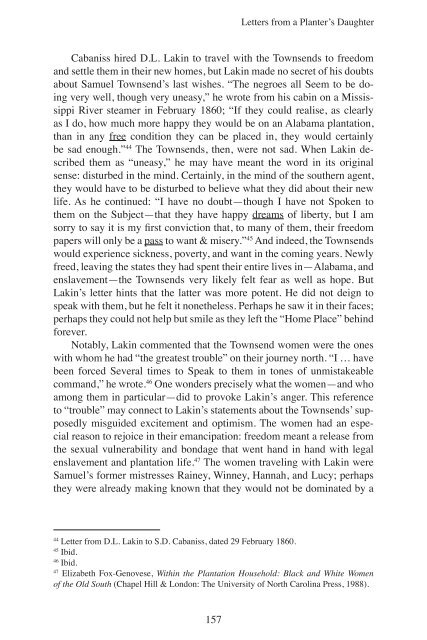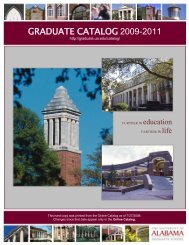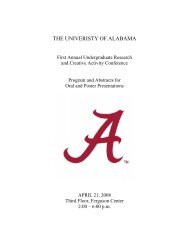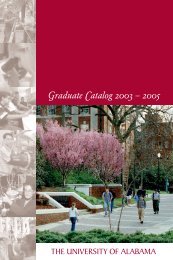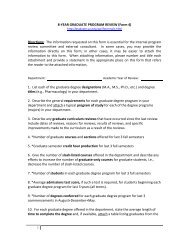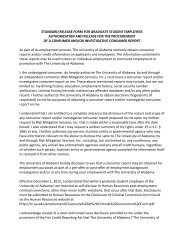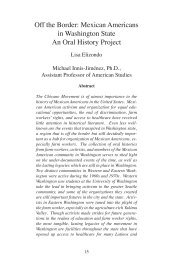Letters from a Planter's Daughter: Understanding Freedom and ...
Letters from a Planter's Daughter: Understanding Freedom and ...
Letters from a Planter's Daughter: Understanding Freedom and ...
Create successful ePaper yourself
Turn your PDF publications into a flip-book with our unique Google optimized e-Paper software.
157<br />
<strong>Letters</strong> <strong>from</strong> a Planter’s <strong>Daughter</strong><br />
Cabaniss hired D.L. Lakin to travel with the Townsends to freedom<br />
<strong>and</strong> settle them in their new homes, but Lakin made no secret of his doubts<br />
about Samuel Townsend’s last wishes. “The negroes all Seem to be doing<br />
very well, though very uneasy,” he wrote <strong>from</strong> his cabin on a Mississippi<br />
River steamer in February 1860; “If they could realise, as clearly<br />
as I do, how much more happy they would be on an Alabama plantation,<br />
than in any free condition they can be placed in, they would certainly<br />
be sad enough.” 44 The Townsends, then, were not sad. When Lakin described<br />
them as “uneasy,” he may have meant the word in its original<br />
sense: disturbed in the mind. Certainly, in the mind of the southern agent,<br />
they would have to be disturbed to believe what they did about their new<br />
life. As he continued: “I have no doubt—though I have not Spoken to<br />
them on the Subject—that they have happy dreams of liberty, but I am<br />
sorry to say it is my first conviction that, to many of them, their freedom<br />
papers will only be a pass to want & misery.” 45 And indeed, the Townsends<br />
would experience sickness, poverty, <strong>and</strong> want in the coming years. Newly<br />
freed, leaving the states they had spent their entire lives in—Alabama, <strong>and</strong><br />
enslavement—the Townsends very likely felt fear as well as hope. But<br />
Lakin’s letter hints that the latter was more potent. He did not deign to<br />
speak with them, but he felt it nonetheless. Perhaps he saw it in their faces;<br />
perhaps they could not help but smile as they left the “Home Place” behind<br />
forever.<br />
Notably, Lakin commented that the Townsend women were the ones<br />
with whom he had “the greatest trouble” on their journey north. “I … have<br />
been forced Several times to Speak to them in tones of unmistakeable<br />
comm<strong>and</strong>,” he wrote. 46 One wonders precisely what the women—<strong>and</strong> who<br />
among them in particular—did to provoke Lakin’s anger. This reference<br />
to “trouble” may connect to Lakin’s statements about the Townsends’ supposedly<br />
misguided excitement <strong>and</strong> optimism. The women had an especial<br />
reason to rejoice in their emancipation: freedom meant a release <strong>from</strong><br />
the sexual vulnerability <strong>and</strong> bondage that went h<strong>and</strong> in h<strong>and</strong> with legal<br />
enslavement <strong>and</strong> plantation life. 47 The women traveling with Lakin were<br />
Samuel’s former mistresses Rainey, Winney, Hannah, <strong>and</strong> Lucy; perhaps<br />
they were already making known that they would not be dominated by a<br />
44 Letter <strong>from</strong> D.L. Lakin to S.D. Cabaniss, dated 29 February 1860.<br />
45 Ibid.<br />
46 Ibid.<br />
47 Elizabeth Fox-Genovese, Within the Plantation Household: Black <strong>and</strong> White Women<br />
of the Old South (Chapel Hill & London: The University of North Carolina Press, 1988).


